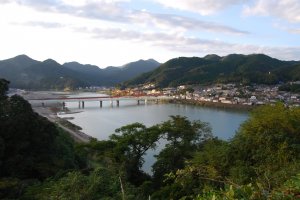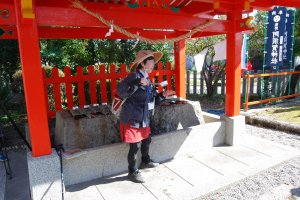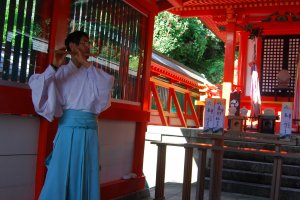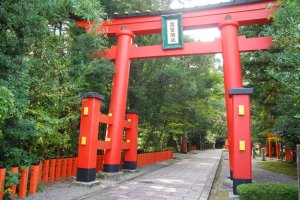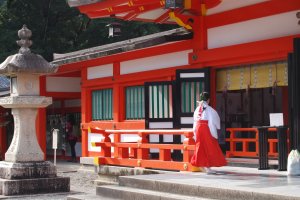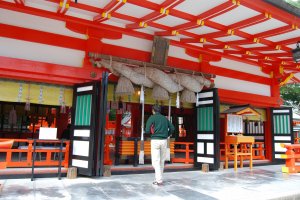A small seaside city in the south of Wakayama Prefecture, Shingu is a treasure trove of holy sites set in beautiful natural surroundings. Whether searching for original history or unique culture, trekking forested mountain paths or searching for a spiritual connection you will find what you are looking for in Shingu.
Since ancient times the remote Kumano area, located in the south of the Kii Peninsula, is thought to be a dwelling place of Kami, or Gods. The Kami-no-michi, or Way of the Kami, now referred to as Shinto, is the indigenous religion of Japan. After Buddhism arrived in Japan in the 6th century, Shinto deities were considered to be incarnations of Buddhist deities. This led to a blend of Shintoism and Buddhism and mountain asceticism which can still be experienced in Kumano. Throughout the centuries this syncretic power spot has attracted spiritual seekers and pilgrims from far afield. Wandering monks opened multiple mountain trails for ascetic training and over time a network of pilgrimage trails developed called the Kumano Kodo, the Kumano Old Road.
The destination of all Kumano Kodo pilgrimage trails leads to the Kumano Sanzan, the Three Kumano Grand Shrines: Kumano Hongu Taisha, Kumano Nachi Taisha and Kumano Hayatama Taisha. They are located respectively in Hongu Town, Nachi Town and in Shingu City. Traditionally pilgrims would visit the Kumano Hongu Taisha first, then ride a boat down Kumano River to the ocean and visit Hayatama Taisha. This is followed by a walk along the ocean shores to reach the base of the mountains on which Nachi Taisha is located. At Nachi Taisha a trail leads back in direction of Hongu, where pilgrims take the long journey home to places all over Japan.
Modern-day pilgrims are flexible to visit the Three Kumano Grand Shrines in any order. If you start with Shingu, the magical journey to Kumano begins right after arrival at Shingu Station or at the Shingu Bus Terminal. Tourists can visit the sights within the city area in a single day on foot or rental bicycle. The following entails a discovery tour of Shingu’s fascinating history and culture:
Jofuku: in search of the elixir of life
From Shingu Station, look across the road and you will see a colorful Chinese gate. This is the entrance to Jofuku Park. Jofuku, or Xu Fu in Chinese, is the name of a Chinese man in the service of the First Emperor of China, Qin Shi Huang, or Shikoutei in Japanese, founder of the Qin Dynasty (221 BC–206 BC). Qin Shi Huang is widely remembered for giving us the Great Wall of China and the Terracotta Army but less known is the fact that he was searching for the Elixir of Life, or Elixir of Immortality. To this end he sponsored a sea voyage to the East led by Jofuku. After an arduous journey, the party landed on Japanese soil in the area of what is today called Shingu. According to legend, Jofuku brought with him 3,000 young people, as well as knowledge and technology about rice farming, fishery, weaving, paper-making and metallurgy, and scientists argue that the influx of parties like this from the Asian continent might have triggered Japan’s change from the Stone Age to the Iron Age.
Jofuku found a plant with medical benefits: Lindera strychnifilia, or Japanese Evergreen Spicebush, Tendai Uyaku in Japanese. This plant was not quite the elixir of life but it turned out to be useful for the treatment of stomach diseases, for which it is being used for even today. In Jofuku Park you will find a statue of Master Jofuku and his tomb and at the tea house within the park visitors can sample a cup of uyaku brew and test the medical properties for yourself.
Asuka Shrine: a priest with a flute
A short walk through Shingu’s backstreets will take you to Asuka Shrine, located at the base of Mount Horai behind which the Kumano River flows into the Pacific Ocean. The geographical features display divine principles. Mount Horai is considered to be the seat of a deity, and the mixing of the waters from the river and the ocean are seen as perfect mingling of yin and yang. This shrine is affiliated with the Hayatama Taisha, and hence the Kami venerated here is the same deity that is worshipped at Hayatama Shrine. A short walk from the gate leads you to the main shrine building in bright vermilion, a color said to ward off evil.
Like all shrines in Japan, you enter through a torii gate first, then you purify at the temizuya water purification basin before you ring the bell, throw in your coin at the donation box and pray Shinto style: bow, bow, clap, clap, bow. If you are lucky, you will meet Mr. Nishi, the kannushi, or Head Priest, of Asuka Shrine. Not only a ceremonial master of Shinto rituals, he has also a musical gift as a proficient player of the shinobue, the Japanese flute. Mr. Nishi even composes his own songs for this traditional instrument. Mr. Nishi composes and plays celestial music to aid travelers in understanding the Way of the Kami. Hearing the sound of the shinobue opens your heart to the spirit and soul of ancient Kumano, which is still lives on today.
Hayatama Taisha: grand shrine near the ocean
We continue our exploration on foot and walk from Asuka Shrine to Hayatama Taisha, cutting through Shingu’s main shopping arcade. Hayatama Taisha is one of the Three Kumano Grand Shrines, and it is Shingu’s top attraction.
Approaching the shrine, you walk across red-lacquered Kebabashi Bridge first, which marks the border between our world and the sacred world of the Kami. Even samurai and noblemen had to alight from their horses here. Passing through a tori gate, you will notice a colorful painting next to a massive, ancient tree. The painting is a replica of the Hayatama Taisha mandala. For centuries, wandering Kumano nuns, called bikuni, would walk across Japan to spread the Kumano faith by explaining about the Three Kumano Grand Shrines depicted in these mandalas. At the same time the nuns would collect donations and encourage people to make a pilgrimage to Kumano. Their base was Myoushin-ji, a temple that still exists in Shingu. The ancient tree, over 17 meters in height and over 5 meters in circumference, is a giant nagi tree, or Broadleaf Podocarpus. This tree was planted by in the 12th century by Taira no Shigemori, the son of Taira no Kiyomori, leader of the famous Taira-clan. This Nagi tree is over 800 years old!
Hayatama Taisha is a “newer” shrine to which the Kami gods were transferred to in the 12th century. Around this new shrine grew a settlement and later a town which was named “new shrine”, or Shingu in Japanese. Taira Shigenmori was not the only historical figure who made the long journey from Kyoto to Kumano. There were a large number of convoys escorting Emperors, retired Emperors and aristocrats from Kyoto, especially from the 11th to 13th centuries. In latter centuries warriors, merchants, and even commoners made also made the pilgrimage to Kumano.
The travelers’ experiences on their spiritual journey were noted in their diaries. These are precious documents for us today that tell us about the history of Kumano as a sacred place and destination of pilgrimages. These travelers also left many items as offerings to the deities, some of which are now on display in the Treasure House of the shrine.
Kamikura Shrine: seat of the Gods
We continue our walk along the backstreets of Shingu through a residential neighborhood, passing by Shingu’s aikido dojo, a couple of temples and Shingu’s No 1 shaved ice shop before we reach one of the oldest sacred places in the Kumano area: Kamikura Shrine.
Legend tells us that Kamikura Shrine is the original place where the Kumano gods descended to earth well before the Hayatama Taisha became the new place of worship. The Kami chose a seat worthy of a Shinto deity, namely a massive boulder overlooking a steep cliff near the peak of Mount Kamikura. Visitors will soon notice after passing through the torii gate at the base of the mountains that paying a visit to the Kami requires fitness and good shoes. 538 stone steps, made of irregularly-shaped field stones, lead to the top. At the beginning the incline is so steep that one may want to walk up on all four legs. Once you reach the top a red gate greets you. Step through and you will soon see the massive boulder with a small shrine building next to it. The strenuous climb is rewarded with a gorgeous view over Shingu City and out to the Pacific Ocean.
The Mt. Kamikura stone steps are difficult to climb and descent on a sunny day and in bright daylight, but imagine for a moment a mob of 2,000 torch-carrying guys ranging from young boys to old men racing down these steps in the dark on a cold and wet February night. Mind you: only guys are allowed to participate while girls can just watch. The record of racing down these steep steps was set at 2 minutes 30 seconds for many years, but this year an unbelievable new record was set: 1 minute 30 seconds. The proud holder of this record is a Shingu firefighter. He surely must have trained hard, and the blazing fire around him from thousands of torches is probably second nature. This event happens on February 6th each year, the night of the Oto Matsuri, Shingu’s fire festival. It is held to drive out evil and welcome the New Year. “Noboriko” is the name given to the guys who participate. They have to purify in the freezing cold waters of the Pacific Ocean in the morning, wear only white clothes and eat only white foods on this day. Before they climb up to Kamikura Shrine after dark, noboriko visit three other sacred places in Shingu and pray there. This ritual is called “sansha mairi” and the three places are: Asuka Shrine, Hayatama Taisha and Myoushinji Temple.
Kumano River: pilgrimage by boat
On the other side of the mountain from Kamikura Shrine is a different type of scenery to capture visitors’ eyes. Leaving Shingu City, you pass through a tunnel and emerge with an unexpected view of wide Kumano River and the ragged Kumano Mountains.
One can imagine how pilgrims in the old days made their way to Shingu with great difficulties. The Kumano River, one of Japan’s three fastest flowing rivers, carved a deep valley into the steep mountains of the Kii Peninsula. The source of Kumano River is near the Omine Mountain range far north on the peninsula in Nara Prefecture, from where it travels 183 km south before it drains into the Pacific Ocean near Shingu.
Visitors can travel by bus to reach the embarkation point for the boats that take modern pilgrims downstream. In the old days pilgrims would have boarded boats near the Hongu Taisha, but nowadays it is further downstream. Two boatmen and a guide are waiting for passengers who are asked to wear orange life jackets, just in case, and wrap a plastic sheet around themselves to be protected against any splash when riding the fast currents of the river. During the two hour journey visitors listen to stories narrated by the guide about pilgrims, nuns and ascetics who traveled along the Kumano River. The guide will also point out many unusual rock formations, several waterfalls, birds and other interesting things along the river. Towards the end of the journey the guide will play a Kumano folk song on the flute. Finally the boat reaches Shingu where passengers alight and walk to Hayatama Taisha.
Kumano Kodo: mystic rock in the forest
The small village of Koguchi is located halfway along the trail that connects the Hongu Taisha with Nachi Taisha. The Kogumotori-goe route links Hongu with Koguchi from where the Ogumotori-goe route leads to Nachi. While modern day pilgrims often walk in the direction of Nachi, traditionally pilgrims would walk from Nachi back to Hongu. Walking in either direction is fine, as nowadays pilgrims and hikers are flexible to visit the Three Kumano Grand Shrines in any order.
From the trailhead near an old abandoned school, the path climbs up continuously. After a few minutes of walking visitors will find themselves in the forest, surrounded by cedar and cypress trees. Once in a while a small stone statue depicting a Buddhist deity sits at the wayside and reminds walkers of the spiritual purpose of their journey. The sunlight finds its way through the trees and the cheerful chirping of birds provides the backdrop for a scenic walk.
After 30 minutes of uphill travel, some stone foundations and stone steps come into sight. Walking up the steps you will see a large bolder overgrown by moss. On closer inspection one can make out three symbols. They are Bonji, letters of the Sanskrit alphabet, and they represent the three Buddhist deities associated with the Three Kumano Grand Shrines.
Yakushi Nyorai (Medical Buddha) relates to Hayatama Taisha, Kannon Bosatsu (Goddess of Mercy, a Bodhisattva) to Nachi Taisha, and Amida Nyorai (Buddha of Limitless Light) to Hongu Taisha. The three together also represent Past, Present and Future. This is Warodaishi, literally round cushion rock. The deities are said to sit here, chat and have tea.
For a short taster of the Kumano Kodo you can walk up to Warodaishi, and then back to Koguchi. The trailhead of the Ogumotori-goe route which leads to Warodaishi is a short walk away from the bus stop. Direct buses connect Shingu with Koguchi and there are several runs throughout the day. Make sure that you check the timetable carefully so that you will not miss the bus back to Shingu as there is no other way of transport.
Shingu is a gateway to the Kumano UNESCO Heritage Sites
If these wonderful sights themselves are not already reason enough to visit Shingu, then maybe their UNESCO status will persuade you.
ious sacred places in Shingu, including Hayatama Taisha and Kamikura Shrine, the river pilgrimage route down Kumano River and the Kumano Kodo pilgrimage trails, including the Ogumotori-goe route, are registered UNESCO World Heritage sites since 2004, and in 2016 Asuka Shrine was added. They are all part of the “Sacred Sites and Pilgrimage Routes in the Kii Mountain Range” that also includes Koyasan and Yoshinoyama.
With so many interesting spots to visit in one place, what are you waiting for? Let’s catch the Nanki Wide View Express from Nagoya or the Kuroshio Express from Kyoto or Osaka and meet in Kumano.
Shingu City is looking forward to welcoming you!


